Olympus M.Zuiko Digital 7-14 mm f/2.8 ED PRO
4. Image resolution
Let’s glance at a graph below and see how the lens compares when it comes to its performance in the frame centre. We took our measurements at 7, 10 and 14 mm.
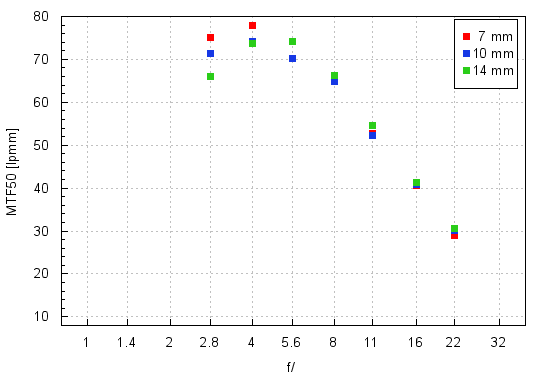
Please Support UsIf you enjoy our reviews and articles, and you want us to continue our work please, support our website by donating through PayPal. The funds are going to be used for paying our editorial team, renting servers, and equipping our testing studio; only that way we will be able to continue providing you interesting content for free. |
- - - - - - - - - - - - - - - - - - - - - - - - - - - - - - - - - - - - - - - - - - - - - - - -
The shortest focal length fares the best –at the maximum relative aperture the MTFs amount to 75 lpmm and on stopping down they go as high as 80 lpmm, pretty high for a zoom lens. Longer focal lengths are slightly worse but the differences are not especially pronounced. There are simply no weak points in the frame centre – a round of applause!
The situation looks a bit different on the edge of the frame and the graph below shows it clearly.
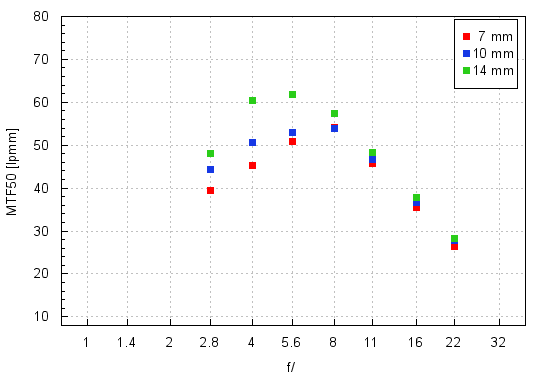
At 14 mm you deal with good image quality, and right up from the maximum relative aperture. In the middle of the focal range the results are a bit weaker but even at the maximum relative aperture the image quality remains useful and good. Predictably the most difficult combination of the widest angle of view and f/2.8 aperture creates most of the problems – it would be difficult to praise the image quality there and in order to enjoy acceptable photos you have to stop the lens down to near f/4.0.
Are these results a good reason to criticize the tested lens for? Definitely not. It would be difficult to find a fast, ultra wide angle zoom lens which doesn’t have any problems on the edge of the frame. Mind you in the case of the Olympus 7-14 those problems are not especially serious, concerning in fact just the combination of the 7 mm focal length and the f/2.8 aperture.
Finally one more issue. There have been a lot of reports over the Internet concerning a significant curvature of the Olympus’s 7-14 mm field of view. To be completely honest that problem didn’t catch my attention during the shooting sessions of the tested lens, anyway it didn’t seem more pronounced than in the case of other lenses with similar parameters. Still, in order to shed more light on that question we decided to investigate further.
Because of the combined contribution of all optical aberrations we aren’t able to separate their influence into components and tell exactly which one is responsible for the quality decrease concerning the field curvature. Still we might make some estimation – in order to do so we analyzed the performance of the lens on horizontal black and white borders both in the frame centre and in some other places, positioned further away. The analysis of just horizontal borders allows you to get rid completely of the influence of the lateral chromatic aberration and partially of the astigmatism.
The graph below shows you the resolution level measured at 7 mm focal length by f/2.8, f/4.0 and f/5.6 apertures in comparison with the resolution in the frame centre measured for different distances from the edge (but not from the corner) of the frame.
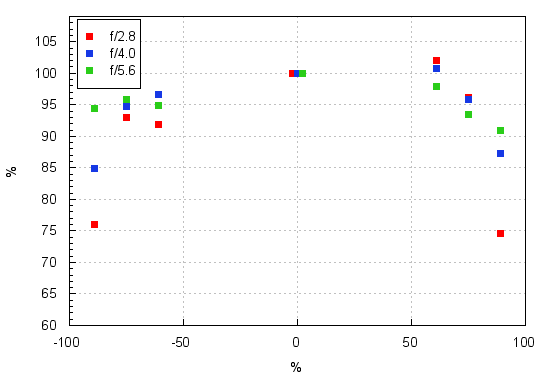
It is clear that from a distance of 75% the MTFs decrease by just several percent from their maximum level; only at the very edge of the frame (so in a distance of about 90% from the centre) the resolution decreases by 25%. That effect diminishes significantly with the stopping down and already by f/5.6 the image is practically flat. On the one hand you might think that 25% of decrease is a lot. On the other hand you should remember that the decrease concerns just the very edge of the field and the field curvature is responsible for only a fraction of it. That’s why the reports about the huge field curvature of the Olympus M.Zuiko Digital 7–14ámm f/2.8 EDáPRO we consider to be exaggerated.
By the way we also checked one more thing. Firstly, even at a difficult combination of 7 mm and f/2.8, where the edges of the frame are below the decency level, our criticism concerns only the very border. Most of the field (up to 75% from the edge) presents images of very good quality and the decrease takes place only after you exceed that value.
What’s more, we feel it is a good place to say that the Micro 4/3 format is at a disadvantage when it comes to the layout of measurement areas on the ISO chart. Our standard resolution measuring area on the edge of the frame is, in the case of such detectors, situated in a distance of 94% from the edge and 75% from the frame corner (and we speak here about distortion corrected images). In the case of sensors with 3:2 sides proportions these values amount to, respectively, 83% and 69%. You should keep that in mind when you want to compare directly the performance of wide angle lenses coming from different systems.
It is already a tradition that we end this chapter with crops of our resolution testing scene, taken from the frame centre. It’s worth reminding here that these are crops taken from JPEG files which were saved along RAW files we analyzed and described above.
| E-PL1, JPEG, 7 mm, f/4.0 |
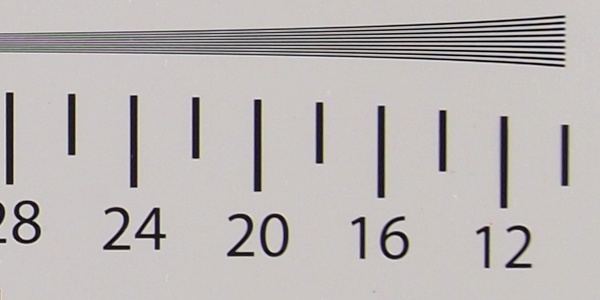 |
| E-PL1, JPEG, 14 mm, f/2.8 |
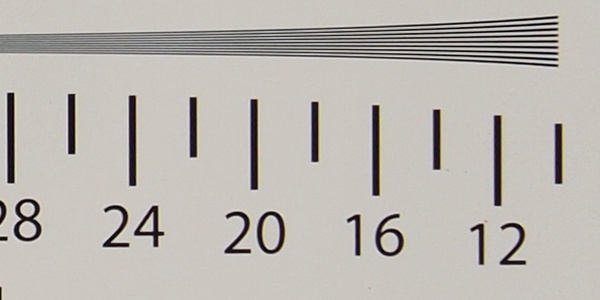 |






